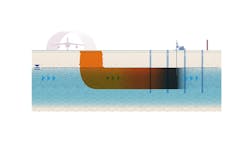PFAS Are Everywhere. Now What?
In August 2022, Stockholm University published a shocking study showing the globally widespread impact of per- and polyfluoroalkyl substances (PFAS) in rainwater at levels above newly established health advisories in the U.S. and drinking water limits in Europe. Incredible as it seems, it is now considered "unsafe" to drink rainwater, even as far as Antarctica.
The study suggests a planetary boundary for PFAS contamination in the environment may have been crossed from which there is no turning back due to the 'forever chemicals' being fully entrained in the hydrologic cycle.
This unfortunate situation, springing from decades of widespread industrial and consumer usage, may lead some to wonder if it might already be too late to do anything about PFAS contamination. After all, how will cleaning up the entire world's freshwater supply be paid for?
As with the other environmental contaminants preceding PFAS, such as benzene or trichloroethene, the highest risk sites will likely be prioritized for cleanup. Since PFAS impacts on drinking water cause the highest risk, remedies will necessarily be focused on preventing future (or more substantial) impacts on groundwater and surface water sources of drinking water.
The immense scope of the PFAS problem demands these remedies be effective, economically viable, and environmentally sustainable.
Effective & Sustainable PFAS Treatment Solutions Using Colloidal Activated Carbon
Over the past decade, scientists and environmental practitioners from Regenesis have deployed a patented colloidal activated carbon (CAC) technology (commercially known as PlumeStop) to treat organic contaminants in groundwater. And since 2016, CAC has been used to remove PFAS from groundwater and eliminate exposure risk, with outstanding results.
CAC is comprised of activated carbon milled to the size of red blood cells (less than 2 microns) and coated with a non-toxic, food-grade additive that prevents clumping and allows the CAC material to flow through aquifer solids, coating them in the process. The treatment transforms the aquifer into a massive underground filter that removes PFAS from groundwater on contact.
The CAC material is typically injected into the subsurface to form permeable reactive barriers (PRB) that filter PFAS out of the groundwater as it passes through. This treatment-in-place (i.e., in-situ) approach removes the exposure risk caused by an advancing PFAS plume, typically for decades following an application.
CAC treatments have demonstrated years of effectiveness in the field, including the world's first in-situ PFAS treatment achieving 100% PFAS removal (i.e., from several thousand parts per trillion to non-detect levels) for more than six years thus far. Further, a third-party, peer-reviewed modeling study predicts that this one-time treatment will effectively contain PFOS (perfluorooctane sulfonic acid), the primary PFAS of concern, at the source for more than 60 years.
Unlike pump and treat, in-situ-applied CAC treatments avoid generating PFAS solid waste materials-, a critical consideration as there have yet to be any legally defined safe disposal methods identified for PFAS wastes. Current EPA guidance suggests that PFAS solid wastes should be stored safely until further research is conducted. This guidance provides the clearest statement of the problems associated with PFAS waste disposal.
Spotlight on PFAS Sources
The EPA has recently turned its attention to PFAS sources, pledging in an April 2022 inter-office memo to use the NPDES program for identifying these sources and restricting PFAS discharges to water bodies.
When left untreated, high concentration source zones like fire training areas can damage billions of gallons of groundwater, leading to contamination of drinking water and potential ill health effects.
A new form of CAC has been recently developed for treating these PFAS source zones. To meet the demand, Regenesis has introduced SourceStop, a concentrated, liquid CAC material comprised of activated carbon particles milled to the size of red blood cells (less than 2 microns), which is applied directly to the subsurface beneath a PFAS source zone. The result is a horizontal barrier that prevents PFAS from leaching, thereby halting groundwater plume development.
Its tiny particle size and colloidal form make it effective at reducing PFAS leaching, with one laboratory study demonstrating more than a 10-times improvement in reducing PFAS leaching compared to powdered activated carbon (PAC).
Source Zone Treatment Systems
Highly optimized source zone treatments might also include in-situ mixing of soil stabilization and solidification amendments (e.g., Portland cement, additional adsorbents) in near-surface soils or surface capping (e.g., concrete, asphalt, compacted clays) to reduce soil permeability. These near-surface treatments, frequently used at landfills and other waste management sites, divert infiltrating rainwater from contacting highly concentrated PFAS, further strengthening source zone treatment effectiveness.
PFAS source zone applications at many sites will be combined with barriers to cut off groundwater plume migration downgradient. The combination of source zone and plume-wide remedies creates an effective PFAS source-plume treatment system that can approximate a permanent solution (i.e., decades to centuries) to mitigate the risk of PFAS environmental and human exposure.
Proactively Treatment Prevents Unnecessary Exposures
PFAS source zones will continue to be discovered worldwide with increasing frequency in the coming years as the US EPA and similar international organizations establish regulations and guidance for addressing PFAS in the environment. U.S. EPA's recent decision to propose designating PFOA and PFOS as hazardous substances under Comprehensive Environmental Response, Compensation and Liability Act (CERCLA) should serve as a catalyst for treating these sources in the U.S.
SourceStop will soon be applied to many PFAS source zones once identified, combined with soil stabilization processes to eliminate source contribution to PFAS groundwater plumes and engineered PlumeStop CAC barriers to halt downstream plume migration. Groundwater industry experts suggest these methods be used to enhance PFAS retention in the subsurface and "can play an important role in reducing PFAS mass flux and providing long‐term protection of downgradient groundwater receptors."
Over time, these targeted CAC treatments will reduce the influx of PFAS loading from sources currently observed at many public water utilities. Proactively addressing PFAS source zones will ensure that it happens sooner rather than later.

